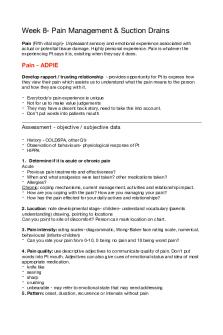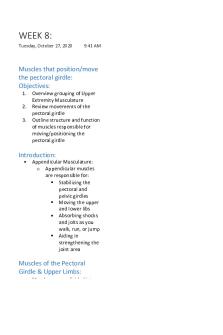Tuberculosis - Lecture notes week 8 - respiratory PDF

| Title | Tuberculosis - Lecture notes week 8 - respiratory |
|---|---|
| Course | MBCHB 3rd Year |
| Institution | University of Glasgow |
| Pages | 3 |
| File Size | 86 KB |
| File Type | |
| Total Downloads | 80 |
| Total Views | 132 |
Summary
week 8 - respiratory...
Description
Tuberculosis
Epidemiology Seen commonly in: o Elderly commonly acquired when younger and stays with them for life, sprouting again due to other reasons o Less developed countries o Immunocompromised Prevention o Public health measures e.g. no spitting o Early detection to prevent development and spread x-rays can identify before symptoms even show Microbiology Mycobacterium tuberculosis o Colonise in fluffy white appearance o Slow growing takes weeks to colonise o Need to use special stains in order to identify: Ziehl Neelsen Stain Pink rod-like bacteria among blue cell components Presents as resistant to alcohol and acid Auramine staining Fluorescent stain yellowish/green Not as specific but more sensitive o Likes apex of lungs higher oxygen concentration Other mycobacteria: o M. Bovis Causes TB in Cows can cause mild infection in humans o M. Kansasii o M. Chelonae o M. Abscessus o M. Fortuitum o M. Leprae causative organism of leprosy Progression of infection Inhaled pathogen due to transmission through coughing up pathogen: o Can be caught by epiglottis and swallowed, preventing the infection 90-95% of infected individuals will control the infection and suppress the pathogen o Develop a TB lesion Ghon complex this is a lesion on the lung, along with an enlarged lymph node into mediastinum Weill not be able to feel lymph node as is not peripheral, but may appear on imaging The healed Ghon complex may cause calcification o However, the pathogen remains in the system as dormant, but can spread haematogenously: DNA can be detected in tissues by in situ PCR in order to prevent reoccurrence o Reactivation of TB can occur later in life:
Cell-mediated immunity gets weaker as we get older Immunosuppression or HIV can cause reactivation Smoking also increase risk of reinfection Progresses to primary progressive TB (cavitary TB) 5-10% of infected individuals will be unable to suppress initial infection and will develop primary progressive TB o This develops cavities of TB which open into the bronchi, enabling the spread of M.Tuberculosis by coughing Types of TB / Complications Miliary TB o This is still in the lung but is wide spread lesions, appearing like millet seeds on x-ray CNS TB o Fairly common o Can spread to brain parenchyma haematogenous spread o Necrotic structures in the brain Typically affects base of brain, affecting lower cranial nerves o Can cause meningitis slower onset Renal TB o Renal parenchyma replaced by calcified material, preventing function Testicular TB o Resembles Tumour but easily treatable Bone and joint TB Pathogenesis microscopic appearance Formation of a granuloma o Central causeous necrosis o This is surrounded by a thin layer of macrophages epithelioid cells Thought to be like epithelium when named but nothing alike o Surrounding this is a collection of highly activated lymphocytes o Also amongst the lymphocytes are various giant cells Immunity to TB Not s sterilised immune response infection is controlled but dormant pathogen remains Cell-mediated immunity is crucial pathogen grows and develops inside cell o Macrophages are the key controlling cell o T cell production of interferon gamma o Cytokines involved in this process are all key Immune response: o Pathogen invades APC (dendritic or macrophage) and survives within the vacuole o This causes MHC II presentation which binds to specific receptor on T cells o The APC produces IL-12 and IL-18 because of the pathogen within it these act on the bound T cells, causing them to proliferate and develop into T-Helper cells o These T-Helper cells now produce Interferon-gamma and TNF key cytokines involved in the augmentation of APC and ability to kill the pathogen Resistance to TB can be due to lack of IFNγ or IL-12/18 deficiency deficiencies in mediator cytokines Detection Mantoux Reaction
TB given under skin, so that it cannot spread anywhere or cause harm but can tell if there has been a reaction o If there has been TB before, and dormant TB is visible, then skin will react to this, producing many granulomas and forming a raised mark (>1.5cm) T spot test o Separated WBCs are counted and added to microtiter plate wells that have been coated with monoclonal antibodies to IFNγ o Disease-specific antigens are added, causing the release of IFNγ from sensitised T cells captured by antibodies o Wells are washed and conjugated secondary antibodies are added to bind to any of the captured IFNγ o Substrate is added to visualise the IFNγ produces highly visible spots o The spots can then be counted 1 spot is 1 T cell o
Treatment The drug treatment has a long duration of 6 months, using a combination of drugs to reduce the rise of resistance o At least two drugs to which bacilli are sensitive must be present drug resistance is increasingly common o Some drugs are only effective when bacilli are dividing rapidly and lack effect against slower growing forms such as pyrazinamide Current regimen: o Rifampicin, Isoniazid, Pyrazinamide and ethambutol Drop ethambutol is sensitive to Rifampicin and Isoniazid Stop pyrazinamide after 2 months Continue Rifampicin and Isoniazid for another 4 months Give prophylactic Pyridoxine to prevent neuropathy caused by Isoniazid Complications: Rifampicin induces cytochrome p450 and thus alters metabolism of many drugs, such as steroids Rifampicin, Isoniazid and Pyrazinamide are metabolised in the liver, increasing the potential for toxicity Ethambutol can affect vision Rifampicin turns urine reddish...
Similar Free PDFs

Tuberculosis - Lecture notes TB
- 11 Pages

Week 8 - Lecture notes 8
- 6 Pages

Week 8 - Lecture notes 8
- 23 Pages

WEEK 8 - Lecture notes 8
- 10 Pages

Week 8 - Lecture notes
- 3 Pages

4 - Lecture notes Week 8
- 2 Pages

GBCM Week 8 - Lecture notes 8
- 8 Pages

Week 8, Part 2 - Lecture notes 8
- 5 Pages
Popular Institutions
- Tinajero National High School - Annex
- Politeknik Caltex Riau
- Yokohama City University
- SGT University
- University of Al-Qadisiyah
- Divine Word College of Vigan
- Techniek College Rotterdam
- Universidade de Santiago
- Universiti Teknologi MARA Cawangan Johor Kampus Pasir Gudang
- Poltekkes Kemenkes Yogyakarta
- Baguio City National High School
- Colegio san marcos
- preparatoria uno
- Centro de Bachillerato Tecnológico Industrial y de Servicios No. 107
- Dalian Maritime University
- Quang Trung Secondary School
- Colegio Tecnológico en Informática
- Corporación Regional de Educación Superior
- Grupo CEDVA
- Dar Al Uloom University
- Centro de Estudios Preuniversitarios de la Universidad Nacional de Ingeniería
- 上智大学
- Aakash International School, Nuna Majara
- San Felipe Neri Catholic School
- Kang Chiao International School - New Taipei City
- Misamis Occidental National High School
- Institución Educativa Escuela Normal Juan Ladrilleros
- Kolehiyo ng Pantukan
- Batanes State College
- Instituto Continental
- Sekolah Menengah Kejuruan Kesehatan Kaltara (Tarakan)
- Colegio de La Inmaculada Concepcion - Cebu







